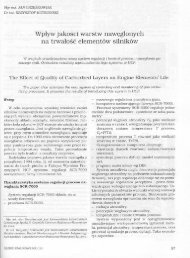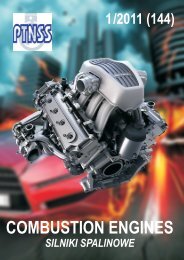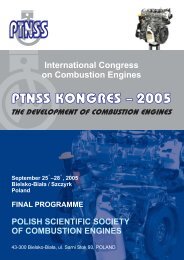Create successful ePaper yourself
Turn your PDF publications into a flip-book with our unique Google optimized e-Paper software.
Wykorzystanie modeli wielorównaniowych do analizy procesów dynamicznych...<br />
Multi-equation models, as demonstrated by the earlier<br />
works of the authors, show a significant adjustment to the<br />
value obtained in the experiment [7 – 11]. However, they<br />
describe the changes in the output parameters (indexes of<br />
exhaust components) in steady states of the engine, when<br />
the influence of structural parameters is not the greatest.<br />
Hence, the problem with the wide variety of changes in the<br />
output parameter. The situation changes when we perform<br />
an analysis of the changes in the output parameters during<br />
transient processes. In the course of their duration, due to,<br />
among other things, imperfections of control systems, there<br />
is a chance of a repeated, though usually short-term instances<br />
when the parameter values are exceeded in comparison to<br />
the set state. The effect of the structural parameters is significantly<br />
greater then, thereby the issue with the variety of<br />
changes in the output parameter is less severe.<br />
Using these operating states, somewhat detrimental to<br />
the engine, the authors decided to implement multi-equation<br />
models for the analysis of dynamic processes tested in the<br />
engine steady states.<br />
2. Identification of a dynamic process of a multiequation<br />
model<br />
Assuming that the process of changing the exhaust<br />
emissions occurs over time, which means it is dynamic,<br />
the multi-equation model can be described with a system<br />
of linear differential equations. Since the measurement of<br />
the concentration of the exhaust components is a discrete<br />
measurement, the time-discrete signal (time sequence) is a<br />
function whose domain is the congregation of integers. Thus,<br />
a discrete-time signal is a sequence of numbers. This kind<br />
of sequences will continue to be recorded in the functional<br />
notation.<br />
Discrete-time signal x[k] is often determined by sampling<br />
x(t), a continuous signal in time. If the sampling is uniform,<br />
then x[k] = x(kT). Constant T is called the sampling period.<br />
The course of the dynamic process in time depends not only<br />
on the value of input functions at a given time but also the<br />
value of input functions in the past. Thus, the dynamic process<br />
(system) has a memory where it stores the consequences<br />
of past interactions.<br />
The relations between the input signals x 1<br />
[k], x 2<br />
[k],...,<br />
x n<br />
[k], and the output signals y 1<br />
[k], y 2<br />
[k],..., y n<br />
[k], k = 0, 1,<br />
2,..., will be described by a system of linear differential<br />
equations:<br />
tym samym problem szerokości pola zmian parametru wyjściowego<br />
jest mniejszy.<br />
Wykorzystując te niekorzystne dla silnika stany pracy,<br />
postanowiono zaimplementować, sprawdzone podczas<br />
stanów ustalonych, modele wielorównaniowe do analizy<br />
procesów dynamicznych.<br />
2. Identyfikacja wielorównaniowego modelu<br />
procesu dynamicznego<br />
Przy założeniu, że proces zmian toksyczności spalin<br />
zachodzi w czasie, czyli ma dynamikę, model wielorównaniowy<br />
można opisać układem liniowych równań różnicowych.<br />
Ponieważ pomiar stężenia związków toksycznych<br />
ma charakter pomiaru dyskretnego, sygnałem dyskretnym w<br />
czasie (szeregiem czasowym) jest funkcja, której dziedziną<br />
jest zbór liczb całkowitych. Zatem sygnał dyskretny w czasie<br />
jest ciągiem liczb. Tego rodzaju ciągi będą dalej zapisywane<br />
w notacji funkcyjnej x[k].<br />
Sygnał x[k] dyskretny w czasie jest często wyznaczany<br />
za pomocą próbkowania sygnału x(t) ciągłego w czasie.<br />
Jeśli próbkowanie jest równomierne, to x[k] = x(kT). Stała<br />
T nazywana jest okresem próbkowania. Przebieg procesu dynamicznego<br />
w czasie zależy nie tylko od wartości wymuszeń<br />
w danej chwili, ale również od wartości tych wymuszeń w<br />
przeszłości. Zatem proces (układ) dynamiczny ma pamięć,<br />
w której są gromadzone skutki przeszłych oddziaływań.<br />
Zależności między sygnałami wejściowymi x 1<br />
[k],<br />
x 2<br />
[k],..., x n<br />
[k] a sygnałami wyjściowymi y 1<br />
[k], y 2<br />
[k],...,<br />
y n<br />
[k], k = 0, 1, 2,..., opisuje się za pomocą układu liniowych<br />
równań różnicowych (4), gdzie: y i<br />
[k], i = 1, 2,...,<br />
m – wartości sygnałów wyjściowych w chwili k, x j<br />
[k],<br />
j = 1, 2,..., n – wartości sygnałów wejściowych w chwili<br />
k, a ij<br />
– współczynnik występujący w i-tym równaniu przy<br />
j-tym sygnale wyjściowym, a ij<br />
– współczynnik występujący<br />
w i- tym równaniu przy j-tym sygnale wejściowym, i, j =<br />
= 1, 2,..., m, b ij<br />
– nieobserwowalny składnik losowy w i-tym<br />
równaniu.<br />
Analogicznie do układu równań (1), układ równań (4)<br />
można zapisać w postaci macierzowej (5), gdzie:<br />
(4)<br />
where: y i<br />
[k], i = 1, 2,..., m – output signal values at k, x j<br />
[k],<br />
j = 1, 2,..., n – input signal values at k, a ij<br />
– is a coefficient<br />
80 <strong>COMBUSTION</strong> <strong>ENGINES</strong>, No. 4/2012 (151)












